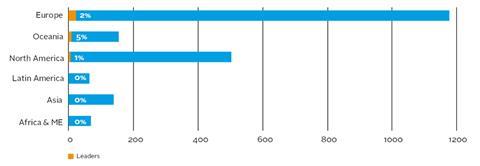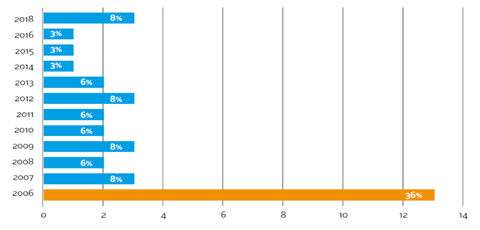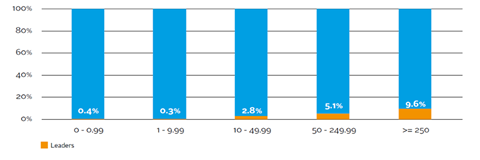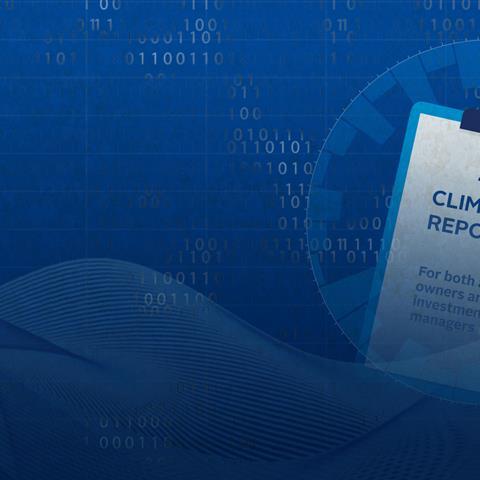The PRI Leaders’ Group 2020 showcases PRI signatories that, in their responses to the PRI Reporting Framework, demonstrate a breadth of responsible investment excellence, and that excel specifically in this year’s theme: climate reporting.
There is no ranking within the group listed in alphabetical order below. To look into any given signatories’ practices in detail, follow the link to their Transparency Report.
The PRI congratulates the following 16 asset owner and 20 investment manager signatories for being included in the PRI Leaders’ Group 2020, in particular for their responsible investment work in climate reporting:
Who was not eligible for the 2020 Leaders’ Group?
- Signatories that are classified as service providers.
- Signatories that opted out of being included in the Leaders’ Group (Reporting Framework indicator CM 10.3).
How does the Leaders’ Group compare to the overall signatory base?
Investor category
While the Leaders’ Group consists of a largely even split between investment managers and asset owners, with 20 investment managers and 16 asset owners identified as leaders in climate reporting, asset owners are better represented relative to the PRI’s total reporting signatory base. Some 4% of all asset owners made it to the 2020 Leaders’ Group, compared to 1% of all investment managers.
Proportion of signatories reporting on climate that are leaders, by investor category

Region
All the leading signatories identified are representatives from European, Oceanian and North American countries. The largest group are European, with 23 identified compared to eight in Oceania and five in North America. In relative terms, Oceanian signatories are particularly well represented: 5% of our Oceanian signatory base is part of the 2020 Leaders’ Group.
Proportion of signatories reporting on climate that are leaders, by region

Sign-up year
Like the 2019 Leaders’ Group, signatories from the PRI’s inaugural year are overrepresented in the 2020 Leaders’ Group. More than a third of those identified signed up to the Principles in 2006, indicating a clear trend for longer standing signatories to demonstrate more advanced practices in climate reporting.
Leaders by sign-up year

Size
Larger signatories are better represented in the 2020 Leaders’ Group than smaller ones, a trend especially visible when looking at the proportion in each size bracket that have been identified as leading signatories. Nearly 10% of signatories with an AUM above US$250bn made it to the Leaders’ Group in 2020, compared to less than 1% of signatories with an AUM below US$10bn. While larger signatories are also better represented in absolute terms, it should be noted that smaller-sized signatories are also able to report well on climate practices. Nearly 50% of the identified leading signatories have an AUM of less than US$50bn.
Proportion of signatories that are leaders, by AUM

Examples of leading climate reporting practices
Governance
LEADERS HAVE: a robust governance structure for climate-related issues
Signatories in the Leaders’ Group have a well-developed process for reporting on climate-related practices, along with robust governance structures to manage them.
Ultimate oversight and accountability for climate-related issues tends to lie with boards, but many leading signatories also demonstrate well-established internal climate and ESG functions, such as cross-functional advisory groups, committees and task forces. Senior-level staff often have
assessment and management responsibilities for climate related issues. They review strategies and policies on climate which cover the entire investment process, from investment beliefs to evaluation, and set priorities and review targets. We see examples of leading signatories that address climate change through an overarching risk reporting framework, where data-driven dashboards are used for senior management to monitor climate risks. Boards receive regular and comprehensive updates to monitor and oversee the progress made on climate-related targets and goals.
In their PRI Transparency Reports, leading signatories are transparent about their governance functions, and often mention the specific internal roles with climate responsibilities. Detailed governance frameworks are further set out in publicly available documents, such as in annual reports and/or policies.
Some of our leading signatories also apply a variety of instruments to foster board and management-level competency on climate issues and link their KPIs and remuneration to climate-related targets, making climate an integral part of their organisations.
PRI resources
Strategy
LEADERS LOOK: at climate risks and opportunities over different time horizons
Leading signatories report on a range of climate-related risks and opportunities, identified using scenario analysis and/or modelling for transitional and physical risks in portfolios and companies. There is a strong trend among the Leaders’ Group to look at different time horizons in their scenario analyses, going beyond short-term risks and opportunities to explore how risks will evolve over time. Many leading signatories publicly provide examples of short, medium and long-term climate risks and opportunities identified as material for their organisations. They all evaluate the potential impact climate-related risks on their investment strategy as well, over a range of time scales within and beyond their investment time horizon.
Almost all leading signatories use a below 2°C scenario, envisioning an orderly transition where countries start to reduce emissions in a consistent and measured way in line with the objectives of the Paris Agreement. Many assess for more than one scenario, by using a 4°C+ scenario and/ or a disorderly scenario in line with the Inevitable Policy Response, based on a forceful and abrupt tightening of climate policy.
Climate-related scenario analysis is used to improve investment decisions, and the leading signatories report multiple uses for their scenario analyses. Examples include stress testing, due diligence, ESG reappraisal, portfolio allocation, stewardship efforts, and to test that their investment strategies are fit for purpose.
Additional resources
- The Use of Scenario Analysis in Disclosure of Climate-Related Risks and Opportunities
- Directory of climate-scenario tools
Risk management
LEADERS: integrate climate-related risk into risk management
The leading signatories use a robust set of tools to manage climate-related risks and opportunities. In addition to using scenario analysis and various metrics to set climate related targets, they provide disclosures on emissions risks to clients, trustees, management and beneficiaries, and encourage internal and external portfolio managers to monitor emission risks. We also see that signatories in the Leaders’ Group formalise emission-risk monitoring and reporting into contracts when appointing managers to manage climate-related risks.
Nearly all leading signatories have processes in place to integrate climate-related risks, such as climate change, into their organisations’ overall risk management policies. They manage climate risks by downgrading ESG scores where relevant and engage with companies where risks are high. They also use their voting rights to vote against board chairs if a company refuses to take adequate steps to improve the quality of management in relation to greenhouse gas (GHG) emissions or risks and opportunities related to the transition into a low-carbon economy.
Many leading signatories are active members of collaborative engagement efforts such as Climate Action 100+, but also engage individually with companies. We see examples of leading signatories that engage with companies to adopt TCFD recommendations and improve disclosure on climate, and that vote against annual reports if companies refuse to adequately disclose climate data. External managers are also actively encouraged to provide TCFD disclosures, and climate considerations are often factored into mandates for external managers to manage risks.
Finally, we also see that leading signatories are participating in policy engagement, including on climate-related risk management.
Additional resources
- The PRI Asset owner guide to TCFD
- TCFD Taskforce guide on risk management1
Metrics and targets
LEADERS: set long and short-term targets
Leading signatories use climate metrics to benchmark their portfolios and track performance over time. The most commonly used key metrics to measure and manage climate-related risks and opportunities in line with their strategies and risk management processes are carbon footprinting (scope 1 and 2), portfolio carbon footprinting, total carbon emissions, carbon intensity and weighted average carbon intensity.
These metrics are used for various purposes. They often determine the performance of holdings in various climate scenarios, the risks and exposure in portfolios, and as such inform investment decisions and stewardship strategies.
Other examples include:
- achieving long-term carbon emissions reduction targets;
- achieving desired exposure to climate-related opportunities; or
- steering investments towards alignment with the Paris Agreement.
Metrics are also used by leading signatories in their climate reporting to demonstrate the GHG emissions intensity of investments to clients and progress towards meeting climate-related targets. They demonstrate long and shortterm accountability by setting multiple targets over different time periods, ranging between 2020 and 2050. An example of targets from leading signatories demonstrating this is to achieve net-zero targets for scope 1 and 2 by 2030 and scope 3 by 2040 for all property assets, and to achieve netzero targets for scope 1 and 2 by 2050 for all assets.
Additional resources
- UK PRA – FCA Climate Financial Risk Forum Disclosure Chapter
- Implementing the Recommendations of the Task Force on Climate-related Financial Disclosures
Frequently asked questions
What is the difference between the PRI Leaders’ Group and the PRI Awards?
Where the Leaders’ Group evaluates broad organisational practice based on PRI reporting and assessment, the PRI Awards recognise individual projects submitted by the signatory, identified by a panel of independent judges.
Why did the PRI choose climate reporting as the 2020 Leaders’ Group theme?
Climate reporting is important to our signatories, as many of them say climate change is one of their most material risks and one of the most important ESG issues. Climate-related risks and opportunities are set to grow in the coming years, and as such, it is increasingly important for investors to incorporate emerging “mega risks” such as climate change into their view of the future. The Financial Stability Board’s (FSB) Task Force on Climate-related Financial Disclosures (TCFD) provides the best available framework for systematically including climate-related risks and opportunities into investment strategy.
Supporting adoption of the recommendations of the FSB TCFD is a high priority for the PRI, as it provides a global framework for translating climate information into financial metrics. As part of our programme of championing climate action, we added climate reporting indicators – designed to complement TCFD reporting – into the PRI Reporting Framework in 2018. Two years on, we are now able to showcase leadership based on investors’ reporting on climate in the PRI Reporting Framework.
How were the 2020 leaders identified?
The PRI Leaders’ Group is based on a different theme each year. In 2020, the theme is climate reporting. All investor signatories – asset owners and investment managers – were eligible. To be considered for the Leaders’ Group 2020, signatories had to demonstrate a strategic approach to aligning their organisation with the FSB TCFD in addition to having an overall good ESG performance.
To assess this, we looked at their publicly disclosed responses throughout the climate change reporting indicators of the Strategy and Governance (SG) module in the Reporting Framework, as well as whether they reported:
- publicly expressing support for the FSB TCFD;
- having a board-approved implementation plan in place (to identify and manage material climate-related risks and opportunities);
- how their organisation is using scenario analysis;
- how their organisation considers both short- and long-term climate risks; and
- working towards specific climate-related targets.
Having screened all signatories against this year’s theme, a combined score using responses from across the Reporting Framework was used to identify, from that pool, the Leaders’ Group 2020.
| COMBINED SCORE | ||
|---|---|---|
|
Strategy & governance 25% |
Implementation 50% |
Transparency 25% |
|
|
|
Which signatories were eligible for the Leaders’ Group?
Signatories must be asset owners or investment managers demonstrating a strategic approach, as identified by the PRI, to aligning their organisation with the FSB TCFD.
Can the PRI share how close my organisation came to the cut-off for the Leaders’ Group?
The PRI will not be sharing any information about how near signatories were to being identified for the Leaders’ Group. The Leaders’ Group is not a ranking of leaders and the signatories that were identified for the Leaders’ Group are presented in alphabetical order.
How confident is the PRI in the information that signatories report and with which the Leaders’ Group are identified?
The Leaders’ Group is based on information signatories provide in the PRI annual reporting process. While the PRI can do some validation checks of data (for example, making reports public and checking contradictory responses), after the reporting cycle, we do rely on signatories to verify their information and report in an accurate manner that will not mis-represent their responsible investment activities. Ultimately, signatories are held accountable for the information they present in their reports by their clients and other stakeholders. While the PRI encourages signatories to use assurance mechanisms, the Leaders’ Group is based on the same self-reported data that underpins all PRI reporting and assessment.
What resources are available to signatories wanting to learn more about the 2020 Leaders’ Group theme, climate reporting?
The 2020 Leaders’ Group report includes several resources for investors wishing to learn more about climate reporting in governance, strategy, risk management, and metrics and targets. We also recommend reading the explanatory notes of the Strategy & Governance module climate change (CC) indicators, exploring the climate change snapshot report, and reading about climate change on our website.
How can leaders share that they are part of the 2020 Leaders’ Group?
We encourage our wider signatory base to learn from leaders’ responsible investment practices. To facilitate this, we have produced a report which summarises the trends in what leading signatories are doing and an interactive table with all leaders’ names in alphabetical order, linking to their public responses to the PRI Reporting Framework. Members of the Leaders’ Group can share this information after the official announcement on 5 October, by using the PRI Leaders’ Group badge, quotes from the letter received from Fiona Reynolds and/or the Leaders’ Group social media card in external communications. We encourage leaders to include a link to the 2020 Leaders’ Group report for full context.
What are the “TCFD recommendations”?
The recommendations from the Financial Stability Board’s Taskforce on Climate-related Financial Disclosure (FSB TCFD) provide a common international framework for companies and investors to translate information about climate change into financial metrics.
What did the FSB TCFD recommend?
Disclosing against eleven questions grouped under four categories: governance, strategy, risk management and metrics.
The recommendations seek to mainstream the management of climate-related risks and opportunities and provide a framework through which organisations can test the resilience of their strategy to climate impacts and policy goals.
Who are the recommendations for?
Both companies, banks, insurers and investors. The FSB TCFD considers investors to be both users and issuers of climate-relate disclosures.
Where should the disclosures take place?
In companies’ and investors’ regular financial filings (e.g. annual reports or periodic client reports).
Is being identified as a leader for the PRI’s 2020 Leaders’ Group equivalent to being fully aligned with the FSB TCFD recommendations?
No, these are not equivalent. All leaders have demonstrated a strategic approach to aligning their organisation with the FSB TCFD, as identified by the PRI. Leaders have been identified based on their responses to the climate-related indicators in the PRI’s Reporting Framework, which complements, but does not fully replace, TCFD reporting.
How will the PRI continue to champion climate change?
Climate change remains the highest priority ESG issue facing investors and the PRI will continue to support signatories in protecting their investments from climate-related risks. Please see our website for the latest investor tools and resources related to our work on championing climate action.
Investors are strongly encouraged to adopt the FSB TCFD recommendations to assess financial impacts of climate-related risks. The Leaders’ Group report aims to help investors learn from the examples of leading practices and associated resources, and to inspire more investors to align their organisations with the FSB TCFD.
What are the next steps for the 2021 Leaders’ Group? How will this fit into the new Reporting Framework?
The PRI will announce the 2021 Leaders’ Group theme when the 2021 reporting cycle begins in January. The Leaders’ Group page on the PRI website will set out the methodology for how leaders are identified. We will continue to use the combined score to assess signatories’ responsible investment performance across their AUM, using the PRI Reporting Framework and assessment to do so. The 2021 screening criteria will be based on the identified theme.
What are your plans for the Leaders’ Group beyond 2021?
Showcasing leadership is part of the PRI’s 10-year Blueprint, and we are currently looking at how to define and showcase leadership further as part of our next three-year strategy.
Downloads
Leaders Group 2020
PDF, Size 3.59 mb
References
1 The TCFD is working on new guidance for implementing the risk management recommendations, to be published in 2020.










